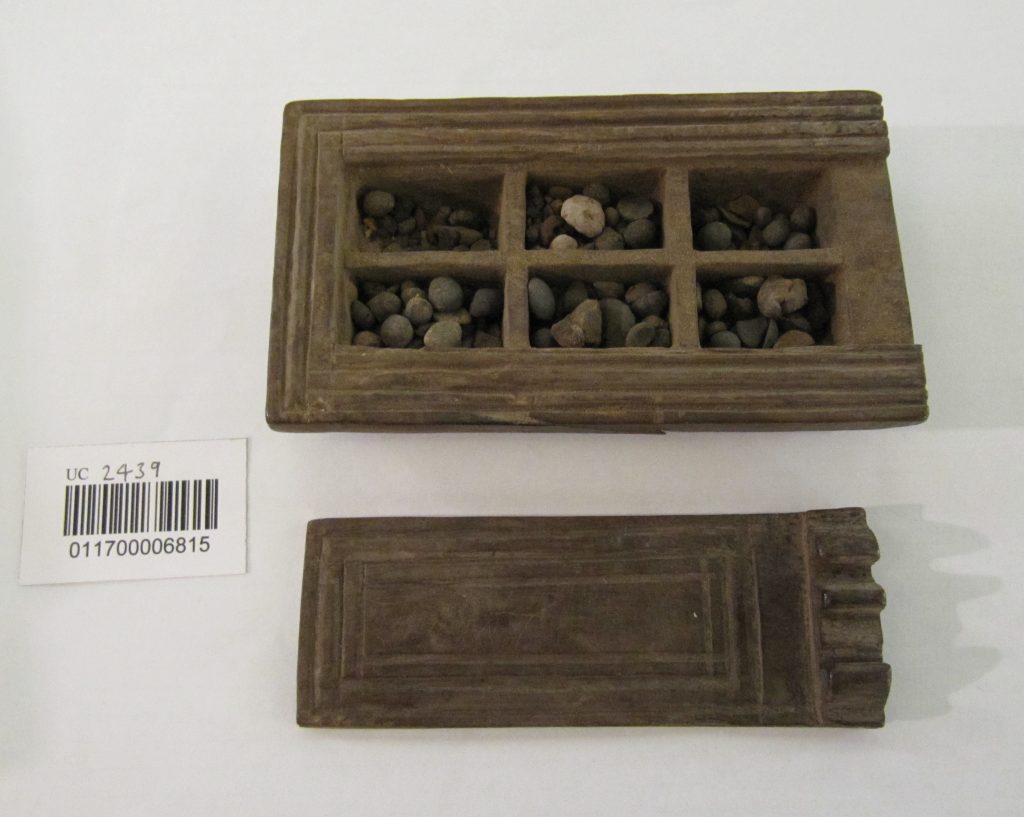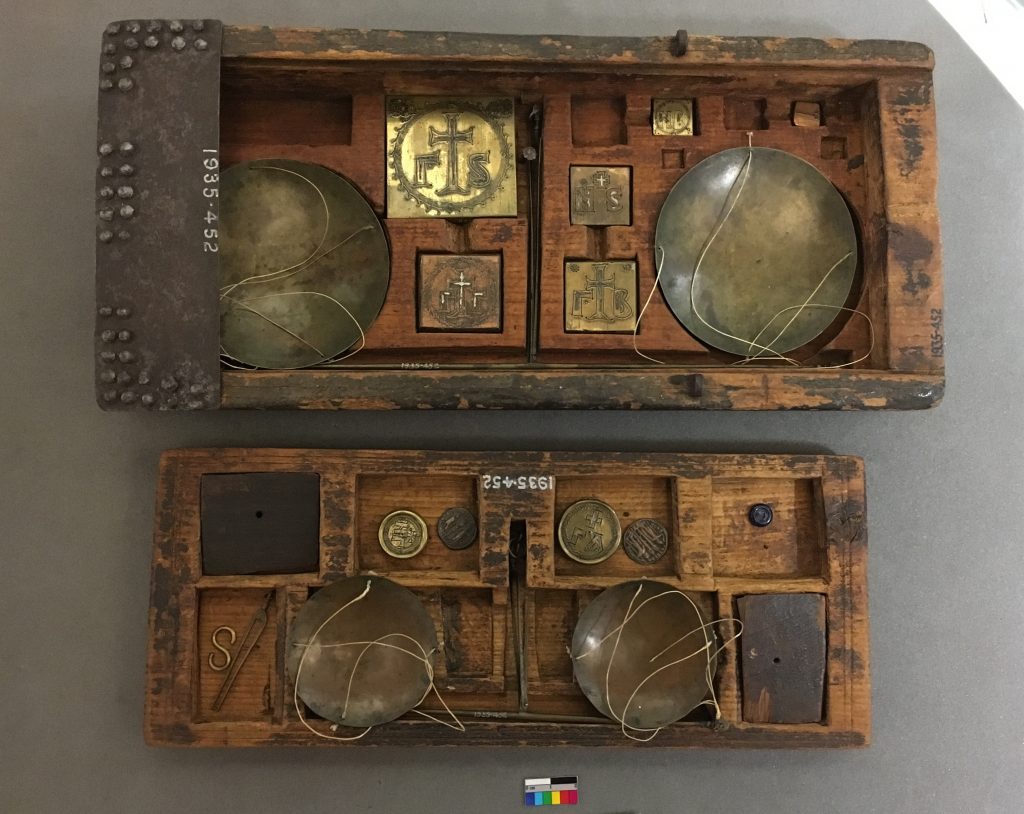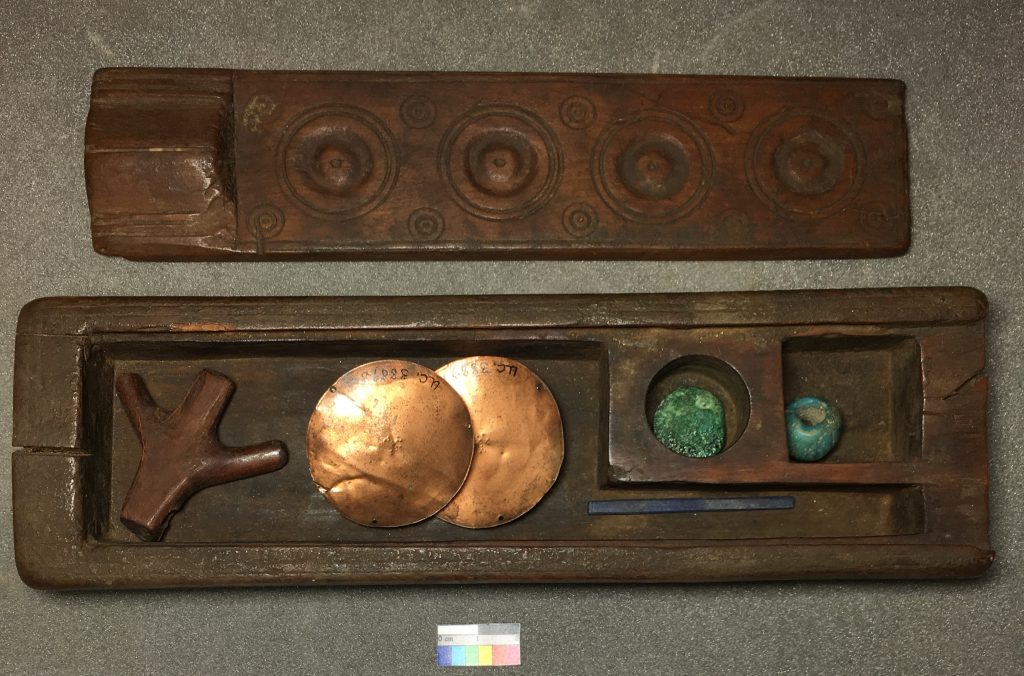The excellent preservation conditions of Egypt allow organic materials – such as wood, leather and plant fibres – to survive in a way that they cannot in the damper climates of Europe. Thus the Petrie collection contains a range of objects rarely found elsewhere in the Roman Empire. Furthermore, perishable contents that might otherwise have deteriorated over time are often still in place, providing a valuable insight into artefact assemblages and what different containers might have been used for in Roman Egypt.
There are a number of wooden boxes within the Petrie’s collection that still have their contents extant. These boxes, whilst of different sizes, generally take the same form – of a long rectangular container, often with compartments within, topped with a sliding lid.

One such box in the collection is carved from a solid piece of dark brown wood, and feels heavy and of a good quality. It has decorative incised grooves along the top, and when the top is removed six compartments are revealed. Astonishingly, the contents are still in situ – each compartment is filled with pellets of what appear to be an organic substance. Their texture and colour resemble resin that has been formed into small balls. Furthermore, their presence within a securely lidded box suggests a certain level of value – therefore these small balls of matter might be pellets of incense, or some other desirable aromatic (sadly, having given them a sniff, there is no longer any aroma detectable!).
Another lidded box in the Petrie’s Roman collection reveals a different set of objects within.

This item is clearly made to specifically contain a set of scales, parts of which are still found within it (there are several other boxes in the Petrie Museum that have the same pattern of recessed shapes within them, but are missing their contents). This one has one set of scales pans, a bronze weight, and a needle. The pans, which have 3 holes each to accommodate the string that would have attached them to the balance arm, fit the circular recesses in the box perfectly, suggesting they represent the box’s original contents. However the weight – inscribed with a ‘N’ and of the Roman Ungia/Uncia standard – is clearly too small for the rectangular compartments. The third object in the box is a copper alloy needle, again clearly not original to the box but perhaps instead used as a replacement for the original balance and scale arms that are no longer part of the assemblage. The contents of the box might therefore represent a later stage in the life of this piece of equipment, with items added or being repurposed to fill in for the lost or damaged originals.
It is a similar story for the larger box UC80559, a much larger lidded box that contains two levels of carefully shaped recesses for scales pans, balance arms, and weights.

The large pans on the inset tray are too large for the circular recesses. However, one loose pan located underneath them fits perfectly, as do the pans stored in the level beneath the tray which also are of a similar colour copper alloy to the loose pan above. This suggests that they actually represent the original contents of the box, with the larger pans a later addition.

Many of the weight sections are also empty, with the original contents lost. Their replacements are two coins, along with a very small blue blob of glass, also a weight (UC80570). This weighs only 0.36 grams so must have been used for a light or expensive commodity that would be used in small amounts – perhaps spices or medicines.
One final box is worth mentioning in this context as it also contains a coin. The contents are a true mismatch of items, none of which fit the carved compartments, and consist of 2 scales pans, some sort of wooden fitting (perhaps used in a balance), a melon bead, a rod of glass, and a coin dated to the Ptolemaic period.


The coin is badly corroded, but weighs 4.94 grams, very close to that of the N-inscribed Uncia weight mentioned above, which weighs 4.72 grams. This Ptolemaic coin also has an irregular shape despite the corrosion, with one distinct flat edge – this might represent the coin being clipped to adjust the weight and ensure its suitability for use in the scales set.
There are many more examples of containers that still have their contents within the Petrie, providing us with a valuable insight into the life span of objects, and the way assemblages can change over time to meet the different needs of their owners. We’ll bring you some more examples of objects and their contents in some future posts!
